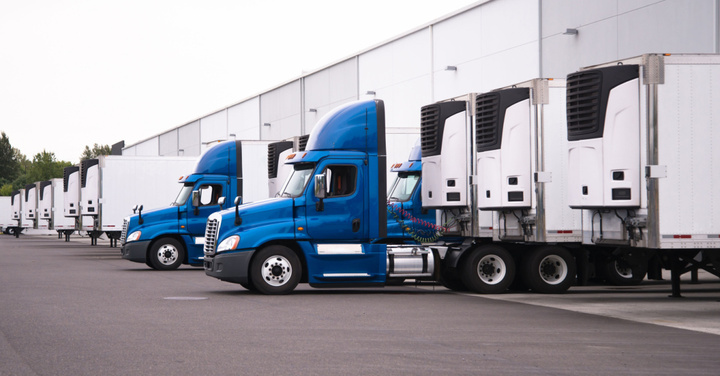The need to get food, medicine, and drinks from point A to B is constantly growing. These needs continue to grow due to market instability post-pandemic and the continued recovery in goods purchases. Catching up the supply chain is still happening and will reverberate through the reefer segment for years to come.
Cold freight transfers are necessary, not a luxury, especially for foodstuffs that spoil quickly. For those of us that frequently visit the grocery store for some Ben & Jerry’s ice cream, we owe reefer drivers for each cold, tasty bite.
What is a Reefer?
A reefer is a refrigerated trailer used to transport temperature-sensitive goods and perishables. The start of reefer trucking in 1925 is attributable to the ice cream industry. And yes, reefers can be used to haul heated goods as well.
How Does Reefer Trucking Work?
Reefers use interior vents and insulation as the contributors to keep goods in the desired condition. The use of cooling systems necessary for transporting refrigerated and frozen freight sets reefers apart from cooling vans.
Driving the compressor in reefer trailers is a small diesel engine that creates a pulling effect on the gaseous refrigerant. In this process, the gas is liquefied and heats the compressor’s body, impacting the trailer’s internal temperature. This process is a heat exchange that occurs in the unit’s condenser, and it’s very similar to how your radiator cools your engine.
After losing most of its heat, the liquefied gas remains under pressure and is pushed into the evaporator by the condenser. When evaporating, the gas cools, and a metering valve controls the amount of refrigerant the evaporator receives.
Always within the evaporator is another rapidly-expanding refrigerant that absorbs heat from the trailer when its expansion turns it into a gas. The trailer’s air moves into the evaporator, then to the compressor, and repeats the process.
This process is how the trailer is cooled to ensure refrigeration. Before the shipment, the cargo is often stored in pre-coolers to keep conditions perfect during transport.
What Type of Freight Do Reefers Transport?
A tremendous variety of goods require temperature-controlled trailers for their transportation. Some temperature-sensitive goods are perishables, plants, chemicals, flammable products, and pharmaceuticals.
Perishables include items that go bad quickly, and some examples include:
- Dairy products
- Poultry
- Beef
- Eggs
- Fish
- Any fruit or vegetable that has been chopped or cut (like a premade salad or fruit tray)
Can Reefers Carry Dry Freight?
Reefers are great for carrying dry freight, and doing so is a way to keep them in use during periods of lower trailer need, like between harvests. There are some benefits for shippers needing to move dry goods.
The benefits of shipping dry goods in a reefer are:
- More economical: A reefer offers 25% more space than a dry goods van, reducing shipping costs. Also, getting reefers to produce producing regions during the busy and lucrative harvest season results in low inbound lane rates your freight broker can secure for you.
- Excellent protection: An enclosed trailer protects goods from weather and sunlight. Also, the ability to lock the trailer ensures that goods are kept secure.
What Requirements are Associated With Reefers?
Truckers hauling a reefer trailer are regulated by the Food and Drug Administration (FDA) through the Food Safety Modernization Act (FSMA) to protect foods by keeping them safe from contamination. The act includes seven rules, and a driver’s primary concern needs to be the Sanitary Transportation Rule.
The rule was instituted to prevent transportation practices that result in food safety risks. Some of those risks include the following:
- The failure to properly refrigerate food
- Poor vehicle cleaning between loads
- Failure to protect food
Specifically, the rule has four specific requirements for the protection of food. To directly quote the FDA’s website:
- Vehicles and transportation equipment: The design and maintenance of vehicles and transportation equipment to ensure that it does not cause the food that it transports to become unsafe. For example, they must be suitable and adequately cleanable for their intended use and capable of maintaining temperatures necessary for the safe transport of food.
- Transportation operations: The measures taken during transportation to ensure food safety, such as adequate temperature controls, preventing contamination of ready to eat food from touching raw food, protection of food from contamination by non-food items in the same load or previous load, and protection of food from cross-contact, i.e., the unintentional incorporation of a food allergen.
- Training: Training of carrier personnel in sanitary transportation practices and documentation of the training. Carriers covered by the rule are required to provide food safety training to transportation operations personnel when the carrier and shipper agree that the carrier is responsible for sanitary conditions during transport.
- Records: Maintenance of records of written procedures, agreements and training (required of carriers). The required retention time for these records depends upon the type of record and when the covered activity occurred, but does not exceed 12 months.
What Do Shippers Need to Know About Shipping Temperature-Controlled Freight?
Freight needing temperature-controlled shipping is delicate, and shippers must keep several aspects in mind.
- Work with a provider you trust: Using a provider with an established and successful history of moving refrigerated freight is crucial. They’ll understand the complexities associated with your load and take the proper precautions.
- Be prepared for produce season and how it impacts your freight: When reefers move to produce-producing areas during the picking season, you could have few freight options. Start early, pre-produce season, and establish a capacity plan with your providers.
- Over communicate: Communicate clearly and often for the shipping of sensitive products or when you have highly specific requirements. Written documentation is encouraged. Cold chain visibility options are extremely helpful if offered by the carrier or broker.
- Know the law: FMSA applies to you and the freight company. Know all seven rules and follow those applicable to your business.
What are the Best Practices for Reefer Trucking?
Trucking industry best practices help truckers reduce downtime, increase profits, and enhance their reputations when followed. Best of all, there are only a few to remember and practice to be successful.
- Know the temperature requirements: A driver should identify whether goods need to be heated, cooled, or frozen and the acceptable temperature range. Also, they need to know the expiration dates and delivery timelines.
- Pre-cool the trailer: Drivers must ensure enough lead time to get it to the right temperature for loading.
- Load freight quickly: The longer the doors are open, the harder it is to maintain the trailer’s temperature. Operators must ensure the reefer freight is ready before opening the doors and move the freight quickly and safely.
- Monitor the shipment: Reefer trailers should be outfitted with temperature gauges and monitoring systems. These tools should always be used by drivers before pickup and throughout transport. Diligence and a commitment to monitoring shipments are essential.
- Follow unloading procedures: Freight also has to be unloaded quickly and safely to reduce any chances of damage. Temperature considerations are necessary, and the truck driver must ensure the temperature is correct on the receiving end before opening the door and unloading the freight.
- Keep jumper cables close: The reefer unit is not part of the truck and drains power from its separate batteries. Should those batteries fail, that sensitive cargo is at risk. A driver needs to be prepared to run jumper cables from the tractor to the reefer to protect loads.
Conclusion
Reefer shipping safely gets our foods, drugs, and other sensitive items with temperature requirements to where they need to go, making it one of the essential types of shipping. With each reefer load comes additional requirements and greater complexity to ensure reefer freight is shipped to its specific requirements, and it’s critical to work with carriers that provide the best services.
Consider your carriers carefully, know the specific load requirements, and communicate constantly.


